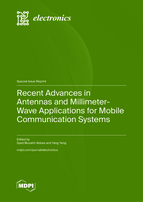Recent Advances in Antennas and Millimeter-Wave Applications for Mobile Communication Systems
A special issue of Electronics (ISSN 2079-9292). This special issue belongs to the section "Microwave and Wireless Communications".
Deadline for manuscript submissions: closed (15 December 2023) | Viewed by 19804
Special Issue Editors
Interests: antennas; electromagnetics; carbon nanotubes; wearable; 3d printing; high-impedance surfaces; frequency-selective surfaces; 5G; mmWave; millimeter wave; PDMS; high gain; base station; UHF; VHF; beam steering
Special Issues, Collections and Topics in MDPI journals
Interests: mm Wave communications; AI-based resource management
Special Issues, Collections and Topics in MDPI journals
Special Issue Information
Dear Colleagues,
With the spectrum scarcity at the sub-6 GHz bands and the increasing demands for extremely high data rates, millimeter-wave (mmWave) communications are regarded as a critical technology for future mobile communication systems. Millimeter-wave frequency bands, which offer abundant underutilized spectral resources, have been explored and exploited in the past several years to meet the requirements of emerging wireless services highlighted by high data rates, ultrareliability, and ultralow delivery latency. Despite the benefits of high data rates and ultralow latency, the unique characteristics of mmWave (e.g., continuous wide bandwidth, large path loss, and penetration loss), along with hardware constraints, introduce great challenges in the design of efficient and robust mmWave communication systems. This requires a great deal of fundamental research on the design of all aspects of antenna and mmWave application, including but not limited to network coordination, channel analysis, antenna design, channel measurement, mobility management, routing, spectrum access, signal processing, resource allocation, interference management and network planning.
Moreover, by incorporating high multiplexing gains achievable with massive antenna arrays, mmWave massive multiple-input–multiple-output (massive MIMO) systems show great potential to significantly raise user throughput, enhance spectral and energy efficiency, and increase the capacity of mobile networks. Although the potential of mmWave massive MIMO is exciting, all aspects of system design require innovative techniques to fulfill the full potential of mmWave massive MIMO, including transceiver architecture, the design of precoding and antenna arrays, channel estimation and feedback, multiple access schemes, and resource allocation.
This Special Issue aims to publish high-quality manuscripts covering new research on topics related to mmWave communications and multiple-antenna technology, including but not limited to signal processing for mmWave networks, mobility management and seamless handover for mmWave networks, PHY design, channel measurement, network analysis, resource allocation, interference management, etc.
Dr. Syed Muzahir Abbas
Dr. Yang Yang
Guest Editors
Manuscript Submission Information
Manuscripts should be submitted online at www.mdpi.com by registering and logging in to this website. Once you are registered, click here to go to the submission form. Manuscripts can be submitted until the deadline. All submissions that pass pre-check are peer-reviewed. Accepted papers will be published continuously in the journal (as soon as accepted) and will be listed together on the special issue website. Research articles, review articles as well as short communications are invited. For planned papers, a title and short abstract (about 100 words) can be sent to the Editorial Office for announcement on this website.
Submitted manuscripts should not have been published previously, nor be under consideration for publication elsewhere (except conference proceedings papers). All manuscripts are thoroughly refereed through a single-blind peer-review process. A guide for authors and other relevant information for submission of manuscripts is available on the Instructions for Authors page. Electronics is an international peer-reviewed open access semimonthly journal published by MDPI.
Please visit the Instructions for Authors page before submitting a manuscript. The Article Processing Charge (APC) for publication in this open access journal is 2400 CHF (Swiss Francs). Submitted papers should be well formatted and use good English. Authors may use MDPI's English editing service prior to publication or during author revisions.
Keywords
- mmWave massive MIMO
- PHY design
- mmWave signal processing
- mmWave networks







